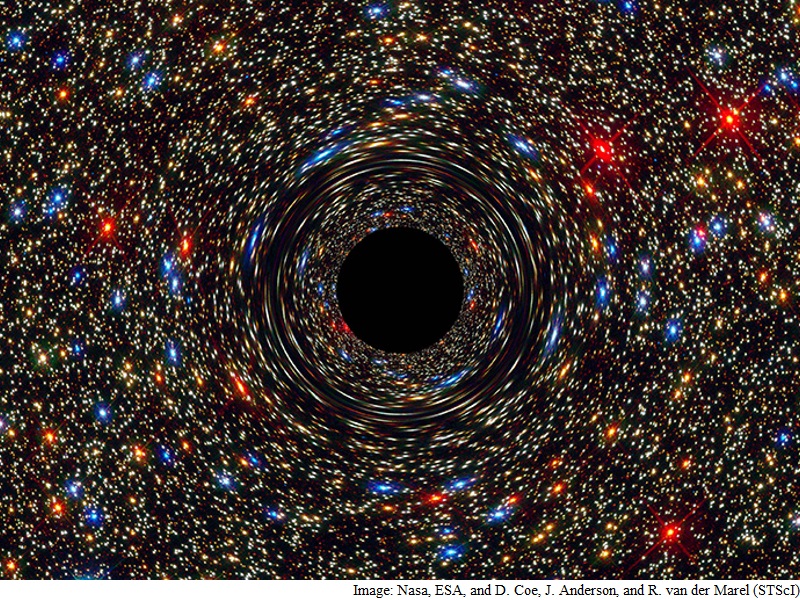- Home
- Science
- Science News
- Supermassive Black Holes May Be Lurking Everywhere in the Universe: Study
Supermassive Black Holes May Be Lurking Everywhere in the Universe: Study

Until now, the biggest supermassive black holes - those with masses around 10 billion times that of our Sun - have been found at the cores of very large galaxies in regions loaded with other large galaxies.
The current record holder, discovered in the Coma Cluster by researchers from University of California Berkeley (UCB) in 2011, tips the scale at 21 billion solar masses and is listed in the Guinness Book of World Records.
"The newly discovered black hole is in a galaxy, NGC 1600, in the opposite part of the sky from the Coma Cluster in a relative desert," said Chung-Pei Ma from UCB.
While finding a gigantic black hole in a massive galaxy in a crowded area of the universe is to be expected, it seemed less likely they could be found in the universe's small towns, researchers said.
"Rich groups of galaxies like the Coma Cluster are very, very rare, but there are quite a few galaxies the size of NGC 1600 that reside in average-size galaxy groups," said Ma.
"So the question now is, 'is this the tip of an iceberg?' Maybe there are a lot more monster black holes out there that do not live in a skyscraper in Manhattan, but in a tal building somewhere in the Midwestern plains," said Ma.
While the black hole discovered in 2011 in the galaxy NGC 4889 in the Coma Cluster was estimated to have an upper limit of 21 billion solar masses, its range of possible masses was large - between 3 billion and 21 billion Suns.
The 17-billion-solar-mass estimate for the central black hole in NGC 1600 is much more precise, with a range of 15.5 to 18.5 billion solar masses.
"The brightest quasars, probably hosting the most massive black holes, do not necessarily have to live in the densest regions of the universe," said Ma.
"NGC 1600 is the first very massive black hole that lives outside a rich environment in the local universe, and could be the first example of a descendant of a very luminous quasar that also didn't live in a privileged site," she said.
NGC 1600 suggests that a key characteristic of a galaxy with binary black holes at its core is that the central, star-depleted region is the same size as the sphere of influence of the central black hole pair, she said.
The findings were published in the journal Nature.
Get your daily dose of tech news, reviews, and insights, in under 80 characters on Gadgets 360 Turbo. Connect with fellow tech lovers on our Forum. Follow us on X, Facebook, WhatsApp, Threads and Google News for instant updates. Catch all the action on our YouTube channel.
Related Stories
- Samsung Galaxy Unpacked 2025
- ChatGPT
- Redmi Note 14 Pro+
- iPhone 16
- Apple Vision Pro
- Oneplus 12
- OnePlus Nord CE 3 Lite 5G
- iPhone 13
- Xiaomi 14 Pro
- Oppo Find N3
- Tecno Spark Go (2023)
- Realme V30
- Best Phones Under 25000
- Samsung Galaxy S24 Series
- Cryptocurrency
- iQoo 12
- Samsung Galaxy S24 Ultra
- Giottus
- Samsung Galaxy Z Flip 5
- Apple 'Scary Fast'
- Housefull 5
- GoPro Hero 12 Black Review
- Invincible Season 2
- JioGlass
- HD Ready TV
- Laptop Under 50000
- Smartwatch Under 10000
- Latest Mobile Phones
- Compare Phones
- Realme P4x 5G
- OnePlus Ace 6T
- OPPO A6x 5G
- Samsung Galaxy Z TriFold
- Poco F8 Ultra
- Poco F8 Pro
- Huawei Mate 80 RS Master Edition
- Huawei Mate 80 Pro Max
- Asus ProArt P16
- MacBook Pro 14-inch (M5, 2025)
- Poco Pad M1
- Poco Pad X1
- Just Corseca Skywatch Pro
- Honor Watch X5
- Acerpure Nitro Z Series 100-inch QLED TV
- Samsung 43 Inch LED Ultra HD (4K) Smart TV (UA43UE81AFULXL)
- Asus ROG Ally
- Nintendo Switch Lite
- Haier 1.6 Ton 5 Star Inverter Split AC (HSU19G-MZAID5BN-INV)
- Haier 1.6 Ton 5 Star Inverter Split AC (HSU19G-MZAIM5BN-INV)

















